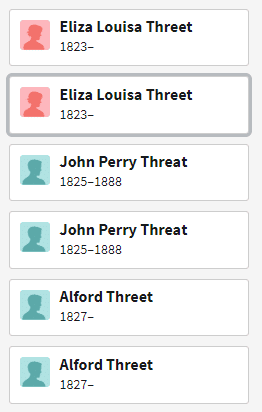By Patricia Hartley
Unlike most projects, you’re never truly “done” with genealogy. Tracing your family’s history can easily become a lifelong pursuit. Locating relevant records, uncovering family stories and overcoming brick walls can take years, or even decades. Therefore, you may wonder what you can possibly accomplish in a mere ten minutes. In reality, though, this short amount of time can be more than enough to make real improvements to your family tree.
10 Ways to Improve Your Family Tree in 10 Minutes or Less
1. Read an article (or two)
If you’re reading this article, you’ve probably already realized there’s always something new to learn about genealogy. It’s inevitable that new technology will emerge, recommended research techniques will evolve, or a previously-offline set of records will become available online. In 10 minutes, you could read at least one article here on Family History Daily, or a genealogical newsletter, and learn something new that will directly impact your research. (Hint: Sign up for our newsletter so the newest additions will be waiting in your mailbox when your next 10 minutes of free time arrives!)
2. Back up your digital tree
Technology is amazing, but it’s not infallible. At any time, your laptop or desktop could become irreparably corrupted or simply shut down forever, taking your family tree software — and your tree — with it. If your main tree resides in a subscription-based online program, you may lose access to some of your work if you forget to renew. Each of these scenarios occurs every day. But if you have some time to spare you can keep this from happening by simply backing up your research to the cloud. (Our four-step guide to backing up and securely storing your work takes less than 10 minutes to read, by the way!)
3. Cite your sources
Creating source citations isn’t the most enjoyable part of family tree research, but it’s perhaps the most important. A fact isn’t a “fact” at all if you haven’t shown where the information came from. When you take a minute (or 10) to add source documentation to an ancestor’s profile, you’re adding immense value to your tree and credibility to your research. Most online programs will automatically cite the sources you add from online records – and adding documentation about the information you’ve gathered from offline sources (like interviews with family members or records from physical repositories) doesn’t have to be daunting. This article from genealogist Bridget Sunderlin makes it easy!
4. Run an error scan
Let’s face it — everyone makes mistakes. When it comes to genealogy, even the most experienced researcher will get caught up in the excitement of uncovering new information and hit the wrong key or forget to complete an entry. In other words, any family tree can contain errors. That’s why the error scan tools available in family tree software are invaluable to keeping your tree complete, accurate, and reliable.
An error scan quickly reviews the data in your tree, picking up obvious — and not so obvious — issues like a mother supposedly giving birth at age 10, a child born four months after his sister, or a person born in 1822 but not yet marked as deceased. Each program differs in the exact types of errors it uncovers, but every error you resolve greatly improves your tree, and a scan takes far less than 10 minutes to complete. You can learn more about running an error scan here.
5. Update your research log
Some of these 10-minute-or-less activities — like reviewing source citations and performing error scans — can also bring to light new avenues to pursue in your research. When you find a hole in your research that needs to be filled or a fact you need to cite, add those to-do’s to your research log. A research log is an essential genealogical tool that helps you keep your research goals and results organized and helps you avoid duplicating your work. Updating your research log with new items takes less than 10 minutes but can save you hours of valuable research time in the future. You can find a research log, as well as instructions on how to use it, as part of our Family History Workbook here.
6. Delete or merge duplicates
If you’ve ever explored other people’s online family trees, you’ve probably seen something like this:

Another easy way to identify these is to scroll through the alphabetical list of all of the individuals in your online tree and look for obvious duplications (here’s how to do that on Ancestry). I actually found the one below on the second page of my alphabetical listing:
It usually takes less than 10 minutes to identify these folks, verify that they are indeed the same person, and merge them into one individual.
7. Search a different database
Sometimes we family historians get so entrenched in our favorite database that we forget about all of the other resources. The next time you have 10 minutes to spare, consider checking out a new website, whether it’s one of the big ones like Ancestry, Family Search, or MyHeritage, or maybe a USGenWeb site for a county you’ve been looking into recently. We’re constantly updating our list of Free Genealogy Sites and Resources with new outlets and types of records you may have never thought about. Fair warning, though: You may want to set a timer for yourself to stop when 10 minutes are up, because you’re likely to discover more interesting things than you bargained for!
8. Reach out to your cousins
With so much of our attention devoted to researching our long-deceased ancestors, it’s easy to forget about the actual living humans in our family trees. Not everyone in your extended family will be interested in doing family history research, but they might be willing to send you family photos, scans of family bibles, or share family stories. However, you’ll never know until you ask. Consider taking a few minutes to reach out to your cousins on Facebook, through email, or even sending a note via snail mail to let them know you’re working on the family tree. You never know who might be holding onto a genealogical treasure!
9. Rename your digital files
OK, so this 10-minute activity isn’t as much fun as some of the others, but it’s something that you’ll be so glad you did the next time you’re searching your computer for that digital image of Great Aunt Gertie, or the scans you made while visiting the archive two counties over. Assigning sensible labels to your digital files isn’t difficult, and it’s a vital element to any genealogical organization system.
We take a deeper dive into filename schemes and how to rename your digital files in our organization course – but a consistent format that includes the name of the subject, applicable dates, and a brief description (image or type of document) is ideal. In 10 minutes you can transform this nonsensical list of images:
… into this logical list of resources:
Honestly, updating those particular filenames took less than five minutes, but you get my drift!
10. Re-read an old document
The longer you’ve been researching your family’s history, the more records and documents you’ve probably added to your collection … and then promptly forgotten. The more we work in genealogy, the more we learn, so it’s always a great idea to go back to the records that have been in your collection the longest and review them with fresh eyes and a more critical and educated perspective.
I recently unearthed paper copies of my third-great-grandfather’s probate record from 1850. When I made those copies at the courthouse in 1993 I was looking only for clues to his death date and to verify his children’s names. When I reviewed those pages a few weeks ago, though, I noticed details like the items in the inventory and the number of acres of land he held, which for me added a great deal of context to his life and standing within the community. Any old document can hold new clues — and uncovering those is a terrific way to spend 10 minutes of your time. This article will walk you through how to do this.
Good luck!
For nearly 30 years Patricia Hartley has researched and written about the ancestry and/or descendancy of her personal family lines, those of her extended family and friends, and of historical figures in her community. She has a B.S. in Professional Writing and English and an M.A. in English from the University of North Alabama in Florence, Alabama, as well as an M.A. in Public Relations/Mass Communications from Kent State University. She’s a member of the Alabama Genealogical Society, Association of Professional Genealogists, National Genealogical Society, International Society of Family History Writers, Tennessee Valley Genealogical Society, Natchez Trace Genealogical Society and the International Institute for Reminiscence and Life Review.





Thank you!
Thank you very much for this post! It’s very timely for me as I’m just getting back to my genealogy after a long hiatus. I realize I have not been doing well with my sources and really need to enter many and redo some.
I have noticed some mistakes in my Tree and therefore are probably more so I am very interested in how to right the wrong! All the other hints are great so I shall work my way through them all. Thank you
Geraldine
Very interesting. I am just getting back into my genealogy and some good info here.
You missed the most obvious one: give the women in your tree their own surnames. If you don’t know a woman’s surname, make that clear by leaving it blank.
Love it..most helpful!